|


I
know, I know. Everybody and their dog Spot knows this flick by its original
title, The Blood Beast Terror. But in the legend of my life,
it looms large as this, it's 1968 re-release title - it was another
movie, like I Drink Your
Blood and I Eat Your Skin, that got away.
Living
in a smallish town in south Texas, I was limited to two theaters: a
movie house and a drive-in (there was a second movie house, but it showed
exclusively Mexican films, and I have never had the Gift of Tongues).
This means that while a fair amount of stuff came through town - I was
not wanting for crap movies to watch - not everything did. Since
for some reason my parents subscribed to either the San Antonio or Corpus
Christi newspapers (SA being the clear favorite), I got to find out
what I was missing, including those delirious five-movie all-night-long
crap movie marathons, the above-mentioned eating & drinking double
feature, and The Vampire Beast Craves Blood.
Oh,
it was on a double feature with something else, but the luridness of
the title and the impressiveness of the accompanying graphic (a Vampire
Beast seeming to reach out of the page) has effectively blotted out
the memory of the opener. I remember thinking, It's finally happened...
they've run out of titles. Then I thought that it was a pretty cool
title; after all, it's one of the very few movie titles that forms a
complete sentence. And Mike Weldon, in the Psychotronic Encyclopedia
of Film, lists it under this title, not the comparatively more prosaic
The Blood Beast Terror. So there.
Goodness,
I'm certainly taking my time getting to the movie itself, aren't I?
There's a reason for this. Some years later, I was told by a friend
that The Vampire Beast in question was actually a large murderous....
moth. Yes, moth. Not a big honking Mothra city destroyer, but some sort
of human-sized were-moth. Oh come now, said I, that is entirely
too stupid. You're right about that, replied the friend.
Pooh pooh, I pooh-poohed him and his misguided antics. I owe
him (and his antics) an apology.
We
open with a young man (William Wilde) being canoed down a river in Africa
by two natives. We know it is Africa because not only are the natives
black, but the man wears a pith helmet, instantly identifying our locale
as the Dark Continent. We also know that we are likely in for a rough
ride, as the sequence is poorly shot (apparently the crew forgot the
tripod that day), and I had no idea that the jungles of Africa are composed
of deciduous trees, much like those in, say, England! Well, the young
man finds what he is looking for, and begins placing things in his specimen
bag. We will later find out that these are the chrysalises (chrysali?)
of moths; quite large ones, about the size of bananas. As we are not
told this until later, we can only surmise what these objects are, and
given their shape and size, several things come to mind... but I am
attempting to keep this page in the PG-13 realm, so we shan't be listing
those.
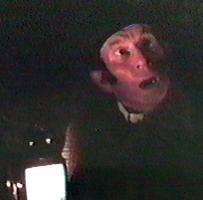 No,
let's just go to our equally-jarring credit sequence, where the camera
is mounted atop a Victorian horse-drawn cab, driving down a country
road on a sunny afternoon as scary music plays. After the credits, the
cabbie hears a scream, and stops the carriage in a convenient spot of
nighttime to get out and investigate. He finds a young man bleeding
to death in the woods, his throat torn by monstrous claws. Hearing the
beating of great wings, the cabbie looks up, and sees a cartoon of an
enormous moth's silhouette, so he gets to scream, too. No,
let's just go to our equally-jarring credit sequence, where the camera
is mounted atop a Victorian horse-drawn cab, driving down a country
road on a sunny afternoon as scary music plays. After the credits, the
cabbie hears a scream, and stops the carriage in a convenient spot of
nighttime to get out and investigate. He finds a young man bleeding
to death in the woods, his throat torn by monstrous claws. Hearing the
beating of great wings, the cabbie looks up, and sees a cartoon of an
enormous moth's silhouette, so he gets to scream, too.
This
cavalier, Ed-Woodian disregard for the difference between night and
day is something that will plague us all the way through Vampire
Beast; filming at night is very difficult, and at the time, there
were basically two ways to shoot day-for-night. One way was to simply
crank away, and add some blue filtering in the post-production phase.
A more common way was to back the iris of the camera off a couple of
f-stops, darkening the whole enterprise. This seems to be the
method employed for much of Vampire Beast, but not employed very
well, as shafts of sunlight peeking through the treetops make it seem
as if the Moon has drawn to within perhaps a mile of the Earth.
Anyway,
the poor fellow bleeding in the woods is victim #6 of the "Slasher",
and Inspector Quannell (Peter Cushing) is having a tough time of it,
as his only witness, the aforementioned Coachman (Leslie Anderson) is
now stark raving mad (or not, as what he is raving about is something
with enormous wings). Quannell decides to visit Dr. Mallinger (Robert
Flemyng), who lives at the edge of the heath where the murders have
been taking place - and the last victim was one of his students.
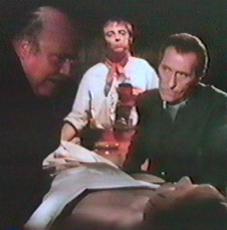 We
find Mallinger lecturing some University students about the various
forms of moth (ooh, what a giveaway!), and in a nod to realism, this
lecture is every bit as boring as one in the real world. Afterwards,
the young men are served a snack by Mallinger's pretty daughter, Claire.
The evening is interrupted by the arrival of another Slasher victim.
Quannell asks Mallinger to attempt to save the young man, but, out of
sight of the Inspector, Mallinger instead kills the unfortunate fellow. We
find Mallinger lecturing some University students about the various
forms of moth (ooh, what a giveaway!), and in a nod to realism, this
lecture is every bit as boring as one in the real world. Afterwards,
the young men are served a snack by Mallinger's pretty daughter, Claire.
The evening is interrupted by the arrival of another Slasher victim.
Quannell asks Mallinger to attempt to save the young man, but, out of
sight of the Inspector, Mallinger instead kills the unfortunate fellow.
Searching
the general area the next day, Sergeant Allen (Glynn Edwards) points
out to Quannell the murder scene, and gives him a handful of what appears
to be sequins; they're scattered all over the crime scene. When Quannell
shows Mallinger the objects, he reacts very suspiciously and tries to
keep all of them; Quannell leaves him with only a few and continues
his investigation.
Arriving
in town is the young man in the prologue, a chap named Brightwell, who
has brought Mallinger the requested moth specimens of large size. After
being quizzed by Sgt. Allen, Brightwell is shown to the doctor's house.
Mallinger is quite enthused by the quality of the specimens, but becomes
irritable and abusive when Brightwell starts poking around his lab.
Claire is enthused by the very presence of Brightwell, and inveigles
to meet him on the heath that night. Too bad for Brightwell, as she
metamorphoses into a human moth thingie, and proceeds to drink his blood.
Complicating
matters is the fact that Quannell is out patrolling the heath personally,
and Brightwell's screams bring him running. Brightwell manages to gasp,
"Deathshead" before succumbing. Quannell drags the wounded
man to Mallinger's house, but too late. Mallinger looks at the corpse
and swears, "I have never seen this man."
The
next day, Quannell prepares to pack his daughter Meg (Vanessa Howard)
off for a holiday (yeah, we didn't know she existed until now, either),
and postponing his own vacation for the sake of the investigation. On
his way to the rail station, he mentions to Sgt. Allen that he needs
to find the identity of the chap killed the previous night; why, I can
tell you that right now, answers the sarge, and relates all the info
he had gotten from Brightwell the day before, including the fact
that Brightwell was on his way to the Mallinger house. Time for
a quick detour to the Mallinger estate, the Inspector tells his protesting
daughter.
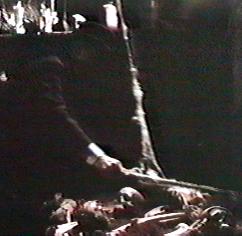 Alas,
after breaking into the locked house, Quannell finds that the Mallingers
have shut everything down and escaped; worse yet, in a room adjoining
the doctor's laboratory, Quannell finds a room strewn with enormous
webs and human bones. The Inspector tells Meg the holiday will just
have to wait, and heads back into town. Employing actual detective work,
Quannell finds out the Mallingers have split for a nearby secluded hamlet,
known mainly as a fishing retreat. Assuming the role of an overworked
banker and his daughter, Quannell and Meg make a working holiday of
it. Alas,
after breaking into the locked house, Quannell finds that the Mallingers
have shut everything down and escaped; worse yet, in a room adjoining
the doctor's laboratory, Quannell finds a room strewn with enormous
webs and human bones. The Inspector tells Meg the holiday will just
have to wait, and heads back into town. Employing actual detective work,
Quannell finds out the Mallingers have split for a nearby secluded hamlet,
known mainly as a fishing retreat. Assuming the role of an overworked
banker and his daughter, Quannell and Meg make a working holiday of
it.
As
luck (and a screenwriter reliant upon coincidence) would have it, they
share their inn with two more early vacationers, a chap named Warrender
(John Paul) and his son, William (David Griffin). In yet another example
of colossal luck, Williams is a budding entomologist, and eventually
supplies Quannell with the two missing clues he needed: the sequin-like
objects found at the murders are scales from the wings of an enormous
moth, and not only that, the cryptic final words "deathshead"
referred to a specific species of moth.
Where
Quannell's detective work fails, though, is that on their previous trips
to the hamlet, the Warrenders made the 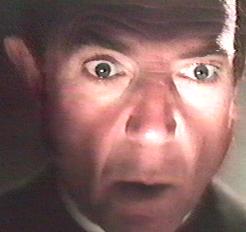 acquaintance
of a certain Mr. Miles, who is also an entomologist, not to mention
the fact that he's the missing Dr. Mallinger! We finally find
out what Mallinger has been up to, all this time... he's trying to make
a mate for his daughter, another giant moth, but this time male.
This isn't going too well, however, as the Mate needs blood to continue
developing... the blood of a young girl! Hmm.... now who has a daughter
in the vicinity? acquaintance
of a certain Mr. Miles, who is also an entomologist, not to mention
the fact that he's the missing Dr. Mallinger! We finally find
out what Mallinger has been up to, all this time... he's trying to make
a mate for his daughter, another giant moth, but this time male.
This isn't going too well, however, as the Mate needs blood to continue
developing... the blood of a young girl! Hmm.... now who has a daughter
in the vicinity?
Well,
it's not long before Meg winds up on a table, mesmerized and hooked
up to a blood transfusion device(I'm not kidding about this - the movie
wisely -but a bit jarringly- skips the scene where Meg is hypnotized).
Demonstrating himself to be a true renaissance man, Mallinger gives
her a post-hypnotic command to forget everything and come back to the
house the next evening. Claire, meantime, in true Lady Chatterly fashion,
has found a strapping young groundskeeper to ply her affections upon.
And to make a tasty snack of, later.
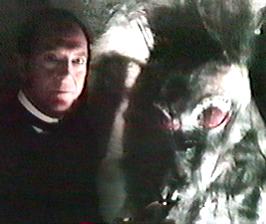 Discovering
the groundskeeper's corpse, Mallinger disposes of the body and then
has a moment of clarity. He destroys the male moth, but makes Stupid
Movie Mistake #12, in that he informs Claire that he is going to destroy
her, too, when he's finished with the male. Never ever tell a
monster you are going to destroy it (alternately, never tell the Mad
Scientist you're going to the authorities). Mallinger inevitably finds
himself wrapped in the scaly wings of death. Discovering
the groundskeeper's corpse, Mallinger disposes of the body and then
has a moment of clarity. He destroys the male moth, but makes Stupid
Movie Mistake #12, in that he informs Claire that he is going to destroy
her, too, when he's finished with the male. Never ever tell a
monster you are going to destroy it (alternately, never tell the Mad
Scientist you're going to the authorities). Mallinger inevitably finds
himself wrapped in the scaly wings of death.
Things
move rapidly from there on. The groundskeeper's body is found, Meg somnabulently
arrives at the Mallinger hideaway, only to be shocked to her senses
by the sight of Mallinger's corpse, and William arrives at the front
door to ask Mallinger's opinion on a moth he had captured and killed
earlier in the day. Of course, only Claire is alive to answer the door,
and William doesn't realize he is bragging about his new Deathshead
specimen to another, two-legged Deathshead....
Quannell,
having finally found out about the existence of Mallinger/Miles, makes
his way to the estate just in time to find his daughter and hear William's
screams. Thinking quickly, Quannell sets a bush on fire, and being a
moth, Claire has no choice but to fly into the flames and goes up in
a smoky foof! The End.
Yes,
yes, I know you're getting tired of this, but the Victorian trappings
and Peter Cushing aside (and the mandatory goofy 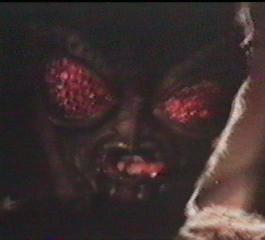 Morgue
Attendant, played by Roy Hudd), this is not a Hammer flick. It's
Tigon. (I'm starting to sound like a margarine commercial here.) Tigon
attempted to become a genre powerhouse like Hammer, and I must
credit them with this: along with their other entries, like Doomwatch
and Blood on Satan's Claw, they did
not go the easy route, and simply imitate Hammer, they tried to do movies
that were decidedly different, even original; it's a shame that
in this case different does not necessarily mean better.
A bloodthirsty were-moth is a hard sell in any case; the fact that the
story is so fragmented, and its execution so lackluster, means that
the beastie has any number of strikes against it at the onset. Morgue
Attendant, played by Roy Hudd), this is not a Hammer flick. It's
Tigon. (I'm starting to sound like a margarine commercial here.) Tigon
attempted to become a genre powerhouse like Hammer, and I must
credit them with this: along with their other entries, like Doomwatch
and Blood on Satan's Claw, they did
not go the easy route, and simply imitate Hammer, they tried to do movies
that were decidedly different, even original; it's a shame that
in this case different does not necessarily mean better.
A bloodthirsty were-moth is a hard sell in any case; the fact that the
story is so fragmented, and its execution so lackluster, means that
the beastie has any number of strikes against it at the onset.
For
instance, it is never made clear whether Claire is actually Mallinger's
daughter and the unfortunate victim of his mad experiments, or if she
has always been a big moth masquerading as a human. And how the hell
do you go about creating a human-sized (and bipedal, to boot) moth?
There is a subplot about Mallinger's scarred manservant, who is always
torturing the Master's pet eagle - after the eagle gives the butler
his inevitable comeuppance, the bird proceeds to vanish from the movie
entirely. Why do Claire's predations seem to begin so suddenly? And
how does a woman wearing a gold dress complete with corset and bustle
change so effortlessly into a killer moth in a black body suit?
The
story also seems obsessed with telegraphing every possible plot development.
A leisurely (albeit doomed) manservant 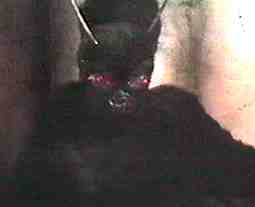 walks
through a room of furniture covered with sheets, long before it has
been discovered Mallinger and Claire have escaped. Claire moves the
groundskeeper away from his pile of burning leaves, because "I
don't like fire," clumsily foreshadowing the end. Quannell's discovery
of the horror within Mallinger's lab gives us some nice rising action,
the sort of thing that is usually reserved for the final act, close
to the end. Unfortunately, the scenes are neither filmed nor scored
with any real drama (the music sounds borrowed from Dark Shadows)
and these events occur in the dead center of the movie. This
would be a gutsy move if the follow-up were not so languidly paced.
The ending, which weaves together several separate plotlines, should
pitch forward like a runaway carriage. Instead, it just seems to trot
along like a cute but moronic dog: Eager to please, but not sure how.
The fact that the Claire-Monster's descent into the fire is represented
solely by out-focus shots of bat-like wings merely tightens the screws
on the movie's coffin. And the creature, flying overhead while
Allen uselessly shoots at it, seems to do so to a drum roll - whether
this is the actual score, or it is supposed to be the sound of her flapping
wings (it is the same sound Yogi Bear makes when running, after
all), I don't know. Don't particularly care, either. walks
through a room of furniture covered with sheets, long before it has
been discovered Mallinger and Claire have escaped. Claire moves the
groundskeeper away from his pile of burning leaves, because "I
don't like fire," clumsily foreshadowing the end. Quannell's discovery
of the horror within Mallinger's lab gives us some nice rising action,
the sort of thing that is usually reserved for the final act, close
to the end. Unfortunately, the scenes are neither filmed nor scored
with any real drama (the music sounds borrowed from Dark Shadows)
and these events occur in the dead center of the movie. This
would be a gutsy move if the follow-up were not so languidly paced.
The ending, which weaves together several separate plotlines, should
pitch forward like a runaway carriage. Instead, it just seems to trot
along like a cute but moronic dog: Eager to please, but not sure how.
The fact that the Claire-Monster's descent into the fire is represented
solely by out-focus shots of bat-like wings merely tightens the screws
on the movie's coffin. And the creature, flying overhead while
Allen uselessly shoots at it, seems to do so to a drum roll - whether
this is the actual score, or it is supposed to be the sound of her flapping
wings (it is the same sound Yogi Bear makes when running, after
all), I don't know. Don't particularly care, either.
Peter
Cushing is yet another sorely-missed actor who serves, by his very presence,
to raise the rating of another otherwise 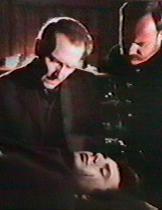 dismal
outing. His innate dignity and intelligence always showed through in
his roles, rendering him instantly recognizable and likable, which is
good since his Quannell (like so many other of the man's roles), just
seems to be the same damned character Cushing did a hundred times before,
only with a different hat. One source reports that he considered this
to be his worst film - the man was on ground zero, I'll respect his
opinion. dismal
outing. His innate dignity and intelligence always showed through in
his roles, rendering him instantly recognizable and likable, which is
good since his Quannell (like so many other of the man's roles), just
seems to be the same damned character Cushing did a hundred times before,
only with a different hat. One source reports that he considered this
to be his worst film - the man was on ground zero, I'll respect his
opinion.
For
the most part, the script plays fair by Quannell. We get to see him
solve the mystery, piece by piece. He seems truly puzzled by the murders,
while each investigative step he takes is well-considered and, incredibly,
realistic. Another nice bit involves Mallinger's University students
using his parlor to put on a play. It's some sort of neo-gothic claptrap
(complete with a tin sheet for thunder) about a mad scientist using
his electrical equipment to bring his dead daughter back to life (the
daughter is played by Claire, in a torn dress revealing far more leg
than would have been allowed in the 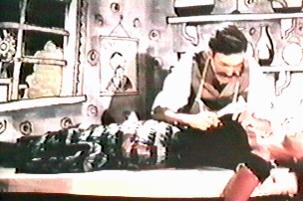 period).
At one point, Quannell, taking a break from patrolling the heath, peeks
in the window, sees this obvious Frankenstein rip-off, and has what
appears to be a genuine laugh at the proceedings. The fact that it is
Cushing, who (arguably) owed his fame to the Hammer Curse of Frankenstein,
makes it an unusually rich cinematic in-joke. period).
At one point, Quannell, taking a break from patrolling the heath, peeks
in the window, sees this obvious Frankenstein rip-off, and has what
appears to be a genuine laugh at the proceedings. The fact that it is
Cushing, who (arguably) owed his fame to the Hammer Curse of Frankenstein,
makes it an unusually rich cinematic in-joke.
It's
also interesting to see how Cushing and the British handle the Dirty
Harry Speech (you know, the one where they try to Take Him Off The Case).
The Chief Constable suggests that Quannell is due for a vacation, and
suggests that he take one. "Sir, are you taking me off the case?"
"No, I just thought you might be too close... a little distance
might do you good." "If you don't mind, sir, I'd rather continue
on the case." "Ah, very well then. Carry on." No yelling,
shouting, or sneering. Quite British. Quite.
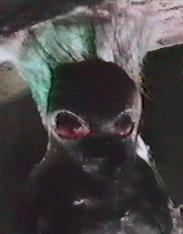 Also,
as I drag out the few nuggets the film actually offers, I have to mention
that their attention to detail in Mallinger's equipment was very good,
including a few pieces of "galvanic" equipment I recognized
from a documentary (not to mention bio lab, what with the kicking frog
legs). Seeing equipment like that, rooted in the technology of the times,
was quite refreshing. Even though I still have no frickin'
idea what galvanism has to do with growing giant moths! Also,
as I drag out the few nuggets the film actually offers, I have to mention
that their attention to detail in Mallinger's equipment was very good,
including a few pieces of "galvanic" equipment I recognized
from a documentary (not to mention bio lab, what with the kicking frog
legs). Seeing equipment like that, rooted in the technology of the times,
was quite refreshing. Even though I still have no frickin'
idea what galvanism has to do with growing giant moths!
Overall,
The Vampire Beast Craves Blood reminds me of a paint-by-numbers
set unearthed after several years with some of the paints missing; the
end product is an echo of earlier pictures, but with a brush stroke
so uninvolving and a palette so limited, that placing it on a wall provides
only a disservice to the wall.
|